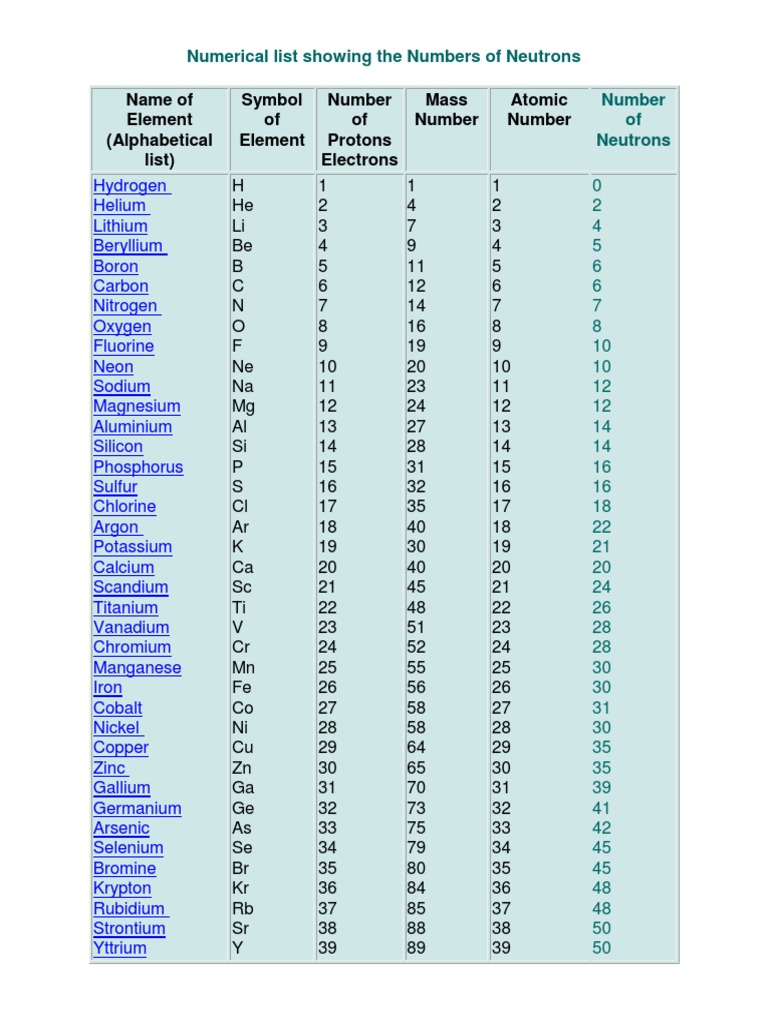The fascinating world of subatomic particles holds the key to understanding not only the structure of matter, but also the fundamental forces that govern the universe. Among these particles, neutrons are particularly notable for their roles in the stability of atomic nuclei and in various nuclear reactions. Although often overshadowed by their charged counterparts, protons, neutrons execute their own vital functions, fulfilling roles akin to the silent architects behind the scenes of atomic architecture.
Neutrons can be fundamentally classified into several types based on various criteria. These classifications offer insights into the diversity and complexity of neutrons, similar to how different knitting styles can produce distinct patterns despite utilizing the same yarn.
1. Free Neutrons vs. Bound Neutrons
Free neutrons are those that exist independently, unbound to any nucleus. They are unstable and undergo beta decay, transforming into protons, electrons, and antineutrinos with a half-life of approximately 14 minutes and 39 seconds. This transitory existence contributes to the dynamic nature of nuclear processes and has vast implications in fields such as cosmology and are frequently utilized in neutron activation analysis.
Conversely, bound neutrons reside within atomic nuclei. They inhabit the quantum realm where their stability is counterbalanced by the strong nuclear force, collaborating with protons to stabilize the nucleus. Their “nuclear embrace” protects the atom from electrostatic repulsion, allowing heavier elements to exist in nature. The interplay of bound neutrons in contributing to the isotopic variations of elements enhances the richness of elemental chemistry.
2. Thermal Neutrons vs. Fast Neutrons
The energy states of neutrons can also classify them into thermal and fast neutrons. Thermal neutrons possess low kinetic energy, evolving from the outcomes of nuclear interactions, often exhibiting energies below 0.025 eV. Their sluggish nature, akin to a languorous stroll through a serene garden, facilitates greater interaction probabilities with atomic nuclei, making them invaluable in nuclear fission processes and applications such as neutron scattering experiments.
In contrast, fast neutrons swarm at higher energies, typically over 1 MeV, resulting from nuclear fission or fusion events. Their swift movements resemble a dart in flight, charged with kinetic energy as they traverse space. Fast neutrons challenge containment strategies due to their propensity for inducing secondary reactions, prompting researchers to devise innovative methodologies, such as moderating techniques, to slow them down for practical applications.
3. Neutron Flavors and Antifarweness
The concept of “neutron flavors” introduces a deeper layer of intrigue, reminiscent of culinary artistry where a simple ingredient can be transformed into a gourmet dish through the right combinations. While neutrons in their essence remain electrically neutral, they are not immutable entities. Their particle-wave duality allows them to oscillate between different states influenced by varying conditions, akin to a musician shifting between notes and keys.
A lesser-explored yet fascinating facet of neutrons relates to their antineutrinos. When a free neutron decays, it releases an antineutrino, a “ghost-like” particle that interacts exceedingly weakly with matter. Antineutrinos are often considered the shadows of neutrons, highlighting the delicate balance between particles in our universe. This aspect of asymmetric decay processes heralds significant implications in nuclear astrophysics and neutrino physics.
4. Neutrons in Reactor Physics and Technology
Neutrons play a pivotal role in nuclear reactors, constituting a fundamental component in the chain reactions that permit nuclear fission. In this setting, they become the protagonists, initiating a cascading reaction that converts uranium or plutonium into fissile materials, propelling the advancement of energy generation. The control rods that modulate neutron behavior are akin to the conductor of an orchestra, harmonizing the extensive interactions to maintain a stable output of energy.
Moreover, research concerning neutron capture therapy highlights their potential in medical science. Cancer treatment is enhanced through the application of thermal neutrons, which selectively target malignant cells, undermining their structure without causing collateral damage to surrounding healthy tissues. In this context, neutrons become silent heroes, wielding the power of precision in the battle against terminal illnesses.
5. Neutron Stars and the Cosmic Continuum
On the cosmic scale, neutrons manifest in the sublime existence of neutron stars, remnants of supernova explosions. These celestial bodies boast incomprehensible densities, where gravitational forces compress neutrons into a quantum liquid state, instilling wonder about the nature of matter in extreme conditions. The resonant vibrations of these stars echo through the cosmos, revealing intricate dance patterns of celestial mechanics that are yet to be fully understood.
The synthesis of elements heavier than iron within supernova ejecta underscores the significance of neutrons in cosmic chemistry, as they facilitate nucleosynthesis through rapid neutron capture processes. As such, neutrons serve as custodians in the cosmic nursery, birthing new elements while contributing to the evolution of galaxies, stars, and ultimately, life itself.
In conclusion, the multifaceted nature of neutrons unveils a captivating narrative of balance, interaction, and transformation. From their classifications as free and bound neutrons to their decisiveness in both terrestrial and cosmic arenas, neutrons shimmer with roles that are as diverse as they are essential. The journey through the subatomic realm reveals a grand tapestry where neutrality contrasts with sheer dynamism, inviting continued exploration and discovery of the fundamental principles that orchestrate the universe.












